Running for Beginners
Running for beginners with helpful exercises

As a running beginner, it is important to start the training with a clear goal in mind. That way you stay motivated and quickly see improvements. We will show you how to find the right speed, how to structure your running training sensibly and how to protect your body from injury.
Picking up running as a beginner isn't that difficult once you've found the motivation and take a few things into account. We'll show you the best way to get started and how to quickly make progress in your training:
How to get motivated for running
Running in a group: Advantages and disadvantages
Finding the right pace
... heart rate monitor
... breathing
Running training
... warm-up
... interval training
... ABC running
Auxiliary strength training
Training frequency
Equipment for beginners
How to get motivated for running
The biggest hurdle for running is getting motivated on a regular basis. A few little tricks can help you to overcome your own laziness.
Setting goals
Setting goals stimulates your ambition enormously. For example, when you are just starting out, make it your goal to run five kilometres in 30 minutes within eight weeks .
It is important that you do not set your goals too high. Not reaching a goal is very frustrating and your motivation goes out the window. In order to reach your goal of running five kilometres, you can also set smaller intermediary goals, such as running for 30 minutes without any breaks, regardless of how far you get.

Bored while running?
Bored yet? Good entertainment does not only help against boredom but it will also distract you a bit, when the going gets tough. You might want to consider listening to
- music,
- podcasts or
- audiobooks
Schedule fixed training times
You need to set aside time for sports. Plan fixed training times. That way, there will be no scheduling conflicts. Now, the excuse "I just didn't have time today" doesn't count anymore.
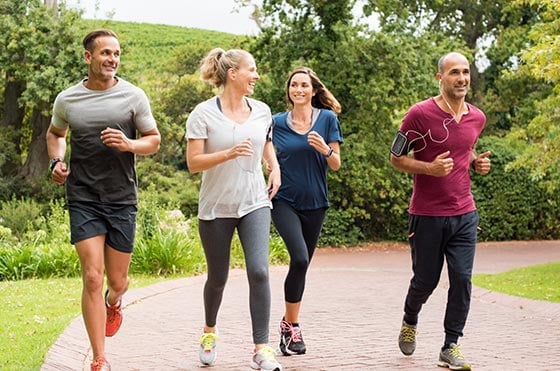
Meeting up with friends
For novice runners, training in a group is a lot more fun. By making plans with your friends, you are tied to a date, which is harder to pull out of. You can also motivate or learn from each other.
Joining a professional running group with a coach
The same principle also applies to a running group. You have a fixed date and in most cases the training is more varied by adding in little exercises. You will also get tips from a professional.
Running in a group: Advantages and disadvantages
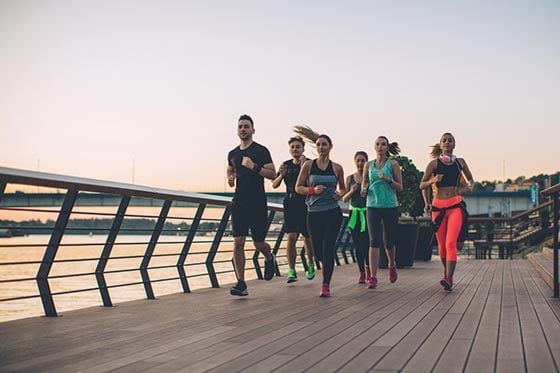
Some enjoy running in a group, others prefer to walk a lonely road. You need to find out for yourself which one you prefer. Training in a group has a few advantages but also disadvantages:
Advantages:
- Mutual motivation
- Distraction
- More fun
Disadvantages:
- Finding your own pace is more difficult.
- Focusing on your own breathing is more difficult.
Training with novices or advanced runners?
This is also completely up to you. Training with fellow novices is less frustrating as everybody is equally inexperienced. In a group with experienced runners you have to be careful not to let the big difference in performance be demotivating. On the other hand, experienced runners serve as motivating role models and can give you helpful tips.
Finding the right pace
You can find your right pace by either using a heart rate monitor or being mindful of your breathing.
Heart rate monitor
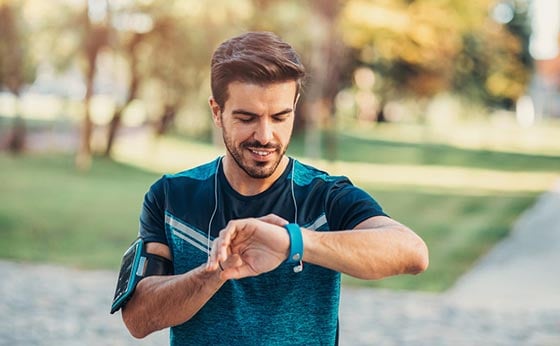
As a novice, you train according to the Basic endurance training GA 1. This means you should train at a frequency of 60 to 75 percent of your maximum heart rate.
To do this, you must first know your maximum heart rate. You can either find this out by performance diagnostics from a sports physician or calculate it yourself with a formula. However, the formula does not take your personal fitness into account and is therefore only a rough guide.
Formula for determining the maximum pulse according to Winfried Spanaus (sports scientist and author of the book "Heart Rate Control in Endurance Sports"):
Men:
HRmax = 223 - 0.9 x Age
Women:
HRmax = 226 - Age
Breathing
Especially for beginners it makes more sense to control the speed by breathing.
You have a good speed if you can inhale once every three steps and exhale once every three steps.
Running training

How you get started running is very individual and depends on the personal basic endurance, which is very different for every running beginner.
It is important that you start slowly and do not run too fast. Before you start jogging, you can also walk.
For beginners, it is not the number of kilometres that counts, but the duration of the training sessions. It is important that you listen to your body and give it as much time as it needs.
If you have joint pain or other complaints, make sure you check with your doctor before training whether jogging is the right sport for you.
At the end of each workout you should plan for approximately five minutes of slow walking so that the circulation gradually recovers from the strain. A few warm-up exercises are recommended at the start of each running session.
Warm-up
Always warm up before running. This will help your joints, muscles and cardiovascular system to get used to the load and minimize the risk of injury.
During your warm up you can, for example, do these three exercises:
Knee rotation
Starting position: Stand straight
-
1. lift your left knee so that your hips and knees each are at 90 degree angles.
2. flex your foot.
3. slowly swing the foot or lower leg to the left and right.
4. make sure that the knee always remains in line with the front of the hip.
Retitions: 10 per leg
Cossack Squat
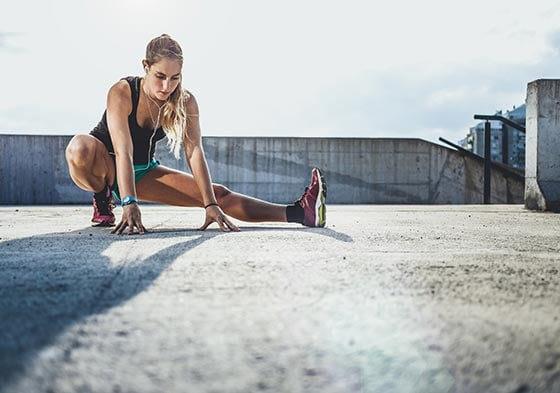
Starting position: Wide stance
-
1. squat towards the left leg.
2. stretch right leg and push your buttocks as far back as possible.
3. flex the foot on the stretched leg.
4. go as deep as you can, bring your buttocks to the right side and stretch your left leg.
Repetitions: 10 on each side
Ankle circles
Starting position: Standing straight
-
1. lift the leg slightly.
2. flex your foot.
3. rotate your ankle in a circular motion.
Repetitions: 10 per foot
In our article „The best stretches before and after a run“, Dr. Christiane Wilke will also tell you which stretches are good for running.
Interval training

Interval training is particularly good for beginners. When you first start out, you alternate between jogging and walking.
You can keep the intervals shorter or longer depending on your personal endurance.
Run: 2-10 minutes
Walk: 45 seconds to 1 minute.
Total training time: Approximately 30 minutes.
Over time you can minimize the intervals. This means that the running times become longer and the rest times shorter.
Your end goalhere is to be able to jog for 30 minutes straight. Give yourself at least four to six weeks time.
Once you have reached your goal, you are no longer considered a beginner and it is time for an individual training plan.
ABC Running

From time to time you can incorporate ABC drills during your interval runs or jogging sessions. This will improve your coordination, running technique and train your muscles.
You can start with the ABC drills after about 10 minutes of running.
Legacy Endurance show us how to do the running ABC's:
The right running technique is particularly important when jogging. In our article "The right running technique", professional runner Pascal Dethlefs explains how you can train it in addition to the running ABC exercises and what you have to consider.
Assisting strength training
When jogging, the knee and hip joints bear a third of your body weight. Strong leg, thigh, gluteal and calf muscles are therefore important. They stabilise your body and take the strain off your joints.
With these three exercises you can train your muscles outside of running:
Squats
Trains: glutes, legs, back and abdominal muscles.
Repetitions: 10–15
With squats you have to be careful to execute the exercise correctly so as not to overload the knee joints. Tom Holland explains how to do this correctly in this video:
Calf raises
Trains: Calfs, thighs and glutes
Repetitions: 5–8
Starting position: Place your toes on a stable elevated surface, such as a stool.
-
1. lean against a wall lightly.
2. lift your heels as far as possible until you are almost on your toes.
3. hold the position and slowly lower the heels again.
4. keep your knees straight throughout the exercise.
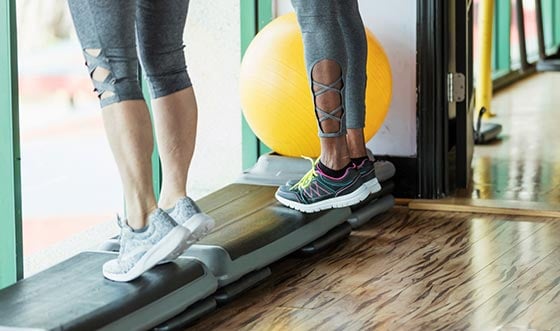
Step ups
Trains: glutes, legs, back and abdominal muscles
Repetitions: 8–10 on each side
Starting position: Stand in front of an elevated surface about 20-40 cm high (e.g. a stool)
-
1. place one leg on the elevation and push the body upwards.
2. make sure that the knee does not tilt inwards but remains aligned above the foot.
3. slowly return back to the ground.
How often to train during the week
If you want to train effectively and get quick training results, you should do three to four training units of 30 minutes each per week .
It is important that you insert at least one rest day between the workout days.
Equipment for running beginners
As a running beginner you don't need much equipment. It is important to have comfortable running clothes in which you feel good and which do not restrict you. Ideally, your sportswear should be breathable. This is more pleasant in summer but also in winter, because the moisture can escape and does not remain on the skin. Read more about how to jog in the winter time and what clothes to wear then in this article.
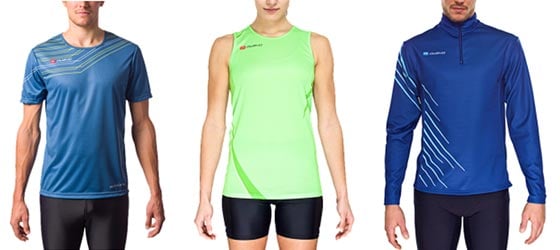
For the summer our running tank top RT5w Pro for ladies and our running jersey R5 Pro for men offer a pleasant wearing comfort. In winter our winter running jersey RLW5 Pro for men and winter long sleeve jersey RLW5w Pro for women effectively protect you from the cold.
Your footwear is of utmost importance. Be sure to seek advice and, if possible, have a treadmill analysis carried out in a specialist shop. A bad or ill-fitting running shoe can quickly lead to joint problems or other ailments.
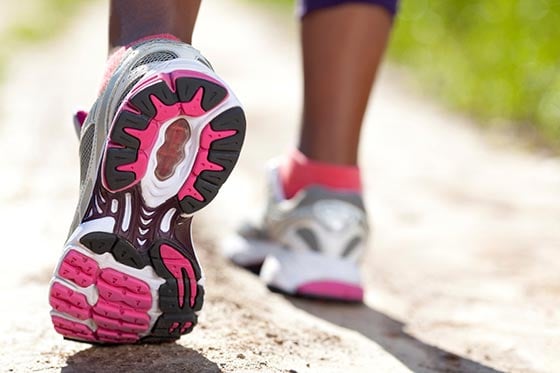
When running at dusk or in the dark, a headlamp is important for your safety. This allows you to see possible obstacles on your way and oncoming runners or road users can see you.
If you want to train according to your heart rate, you need a heart rate monitor. For your smartphone you can also buy cell phone bags for the arm. This allows you to track your progress with an app or call for help in an emergency.
Enjoyable running training
The most important thing with running training is to have fun. This is the only way to stay motivated and achieve success. So give yourself enough time and don't set your goals too high. So that your enjoyment is not tainted by joint pain or other complaints, make sure you train your muscles away from jogging and give your body sufficient rest.
If you find it difficult to overcome your inner weakness, look for a running group with which you can train. In order to strengthen the sense of community, you can also create jerseys with our 3D Kit Designer, for example with a motivational slogan on the back.
Now go out there and have fun!
Photo credits: Title picture: © gettyimages/RyanJLane, Picture 1: © gettyimages/pixelfit, Picture 2: © gettyimages/Ridofranz, Picture 3: © gettyimages/svetikd, Picture 4: © gettyimages/filadendron, Picture 5: © gettyimages/ArtistGNDphotography, Picture 6: © gettyimages/sanjeri, Picture 7: © gettyimages/LeonidKos, Picture 8: © gettyimages/Jacob Ammentorp Lund, Picture 9: © gettyimages/kali9, Picture 10: © owayo, Picture 11: © gettyimages/RuslanDashinsky.